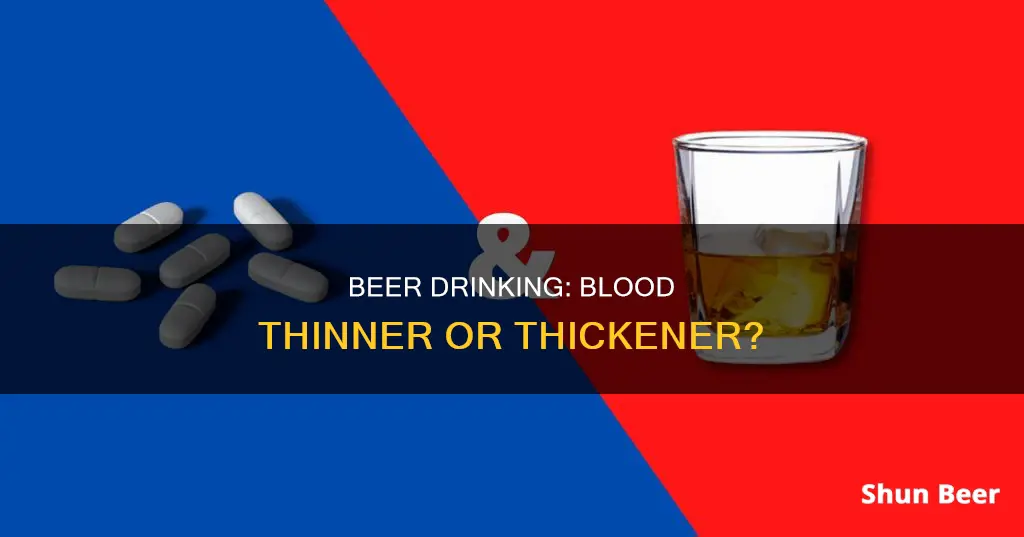
Alcohol is known to have a blood-thinning effect, which can be beneficial in some cases but also dangerous in others. When a person is injured, their blood cells, called platelets, rush to the site and clump together to form a blood clot and stop the bleeding. Alcohol consumption can reduce the number of platelets in the blood and make the existing platelets less sticky, thus hindering the clotting process. While this may lower the risk of strokes caused by blockages in blood vessels, it can also increase the risk of bleeding-type strokes, especially when consumed in large quantities. For this reason, those taking anticoagulant medications should limit their alcohol intake as the combined effects can lead to excessive bruising and bleeding, including internal bleeding.
| Characteristics | Values |
|---|---|
| Effect on blood clotting | Alcohol reduces the ability of blood to clot by reducing the number of platelets and making them less sticky. |
| Risk of bleeding | Alcohol increases the risk of bleeding, especially when combined with blood thinners. |
| Risk of cardiovascular issues | Heavy drinking is associated with an increased risk of high blood pressure, heart disease, and arrhythmias. |
| Liver function | Alcohol can interfere with the liver's ability to metabolize medications effectively. |
| Effect on cortisol levels | Alcohol increases the release of the stress hormone cortisol, leading to higher blood pressure and a faster heartbeat. |
| Recommended intake | For men: up to two drinks per day. For women: up to one drink per day. |
What You'll Learn

Beer and blood thinner medication
Beer, like other alcoholic drinks, can thin the blood. Alcohol consumption hinders the blood's ability to clot by reducing the number of platelets in the blood and making the remaining platelets less sticky. This means that injuries may bleed for longer, and there is a higher risk of internal bleeding. For this reason, people taking blood-thinning medication should be cautious about drinking beer or other alcoholic drinks.
Blood-thinning medication, also known as anticoagulants, is prescribed to prevent blood clots that can cause a heart attack or stroke. These medications include warfarin, rivaroxaban, apixaban, dabigatran, and aspirin. When combined with alcohol, the anticoagulant effects are heightened, which can lead to excessive bleeding. This is why it is important for people taking blood thinners to be mindful of their alcohol consumption and to consult their doctor for advice.
The liver breaks down both alcohol and blood-thinning medication. If the liver is busy breaking down alcohol, the level of the drug in the blood will be higher, which further increases the risk of bleeding. This means that drinking beer or other alcoholic drinks while taking blood thinners can be dangerous, and it may be recommended to avoid alcohol completely.
However, some studies have found that low to moderate alcohol consumption is generally safe for people taking blood-thinning medication. According to this research, having one or two drinks infrequently is considered safe. Nevertheless, it is important to speak to a healthcare provider before drinking any amount of alcohol while taking blood thinners. The doctor may advise adjusting the dosage of the blood-thinning medication or using an alternative medication with lower risks when combined with alcohol. Regular blood tests may also be recommended to monitor clotting parameters.
Drinking Laws in the 80s: Beer and Being 18
You may want to see also

Alcohol and blood clotting
Alcohol can indeed thin the blood, and this has implications for blood clotting. Blood clotting is an essential process that prevents blood loss when a person is injured. However, it can also have adverse effects, such as thrombosis, where a blood clot forms and limits blood flow in the arteries.
Alcohol interferes with the clotting process by reducing the number of platelets in the blood and making existing platelets less "sticky," hindering their ability to clump together and form a clot. This effect can be beneficial in preventing certain types of strokes caused by blockages in blood vessels. However, it can also increase the risk of bleeding-type strokes, especially when consumed in large quantities. For example, drinking more than three alcoholic beverages daily could increase the risk of a hemorrhagic stroke, caused by bleeding in the brain.
The impact of alcohol on blood clotting is influenced by the amount consumed and the drinking pattern. Short-term alcohol use can lead to high blood pressure and thinned blood, while long-term excessive drinking can negatively affect heart function and increase the risk of cardiovascular events such as heart attacks and strokes. Moderate alcohol consumption, defined as one or two drinks per day, has been found to decrease cardiovascular disease risk.
It is important to note that alcohol should not be used as a replacement for prescribed blood thinners. While alcohol may have blood-thinning effects, it can also increase the risk of cardiovascular conditions and certain types of blood clots. Additionally, combining alcohol with blood thinner medications can amplify the blood-thinning effect, heightening the risk of bleeding, even from minor injuries. Therefore, individuals taking blood thinners should consult their healthcare providers to determine safe alcohol consumption levels and ensure effective management of their health conditions.
Beer Drinking and Weight Gain: Is There a Link?
You may want to see also

Alcohol and high blood pressure
Secondly, long-term excessive alcohol consumption is associated with an increased risk of high blood pressure. This is because heavy drinking over an extended period can negatively affect the heart's ability to function correctly, compromising its ability to pump blood effectively throughout the body. As a result, long-term excessive alcohol use increases the risk of cardiovascular events such as a heart attack or stroke.
Thirdly, alcohol acts as a blood thinner, interfering with the clotting process. It reduces the number of platelets in the blood and makes existing platelets less "sticky," hindering their ability to clump together and form clots. While this may sound beneficial in preventing blood clots, the risks associated with drinking alcohol outweigh the potential advantages. Excessive alcohol consumption can increase the risk of bleeding-type strokes, especially when consumed in large quantities. For men, this typically means more than two drinks per day, and for women, it is more than one drink per day.
It is important to note that the effects of alcohol on blood pressure and heart health are complex and vary depending on the amount and frequency of consumption. Moderate alcohol consumption, defined as one to two drinks per day, may have a protective effect on cardiovascular health by reducing stress reactivity in the brain. However, excessive drinking or binge drinking can lead to adverse outcomes.
If you have high blood pressure, it is recommended to avoid alcohol or limit your consumption to one or two drinks on occasion. Heavy drinking, such as drinking on multiple consecutive days or consuming large amounts in one sitting, can be dangerous and even deadly for individuals with high blood pressure. It is always best to consult with a healthcare professional to determine safe alcohol consumption levels, especially for those taking blood thinner medications or managing high blood pressure.
Beer and Blood Work: Is One Drink Okay?
You may want to see also

Alcohol and surgery
Drinking alcohol has both short-term and long-term effects on the blood. Alcohol can thin the blood by reducing its natural ability to form clots. This happens because alcohol reduces the number of platelets in the blood and makes the remaining platelets less "sticky". This means that wounds may bleed for longer, and cuts could be more serious.
It is important to be honest with your healthcare providers about your alcohol use. This is because alcohol can have a serious impact on surgery and recovery. It is recommended that you stop drinking alcohol at least 48 hours before surgery, and ideally a week or two in advance. This is because alcohol can cause serious complications during and after surgery, including:
- Problems with anaesthesia: Alcohol and anaesthesia are both metabolised in the liver, which may not be able to keep up. Alcohol can also increase the risk of aspiration (inhaling vomit), which can be fatal.
- Uncontrolled bleeding: Alcohol can thin the blood and interfere with the clotting process, raising the risk of uncontrolled bleeding during surgery.
- Interference with medications: Alcohol can interact with medications given before, during, and after surgery, causing a bad reaction or reducing their effectiveness.
- Increased risk of infection: Alcohol increases the risk of infection of the surgical site, respiratory system, or urinary tract. Poor immune response to infection can lead to sepsis and septic shock, which can be life-threatening.
- Delayed healing: Slowed clotting can delay the healing of surgical wounds, and alcohol-related complications during surgery can cause problems with the liver, pancreas, and nervous system, making recovery more difficult.
- Cardiopulmonary complications: Alcohol affects the heart and lungs and can cause high or low blood pressure, irregular heart rate, and weakened heart muscles.
- Alcohol withdrawal: Untreated alcohol withdrawal can cause complications such as tremors, seizures, hallucinations, delirium tremens, and even death.
Beer Traps: Effective Earwig Control or Urban Myth?
You may want to see also

Alcohol and liver function
Alcohol-related liver disease (ARLD) refers to liver damage caused by excess alcohol intake. The liver is one of the most complex organs in the body and serves many functions, including filtering toxins from the blood, aiding digestion, regulating blood sugar and cholesterol levels, and helping fight infection and disease.
Each time the liver filters alcohol, some liver cells die. While the liver can develop new cells, prolonged alcohol misuse over many years can reduce its ability to regenerate, resulting in serious and permanent liver damage. ARLD has several stages of severity and symptoms, and its common symptoms include yellowing of the eyes and skin (jaundice), swelling in the ankles and tummy, confusion or drowsiness, and vomiting blood or passing blood in stools.
There are three main stages of ARLD: alcoholic fatty liver disease, alcoholic hepatitis, and cirrhosis. Fatty liver disease is the first stage of ARLD and is caused by a large amount of alcohol consumption, even for just a few days. This stage rarely causes any symptoms but indicates harmful alcohol consumption levels. Fatty liver disease is reversible, and the liver should return to normal if one stops drinking alcohol for a few weeks to a few months.
Alcoholic hepatitis is a potentially serious condition that can develop from long-term alcohol misuse or binge drinking. Mild alcoholic hepatitis is usually reversible if one stops drinking permanently. However, severe alcoholic hepatitis is life-threatening and causes many deaths each year.
Cirrhosis is the stage of ARLD where the liver has significant scarring, and there are usually no obvious symptoms. It is generally irreversible, but stopping alcohol consumption immediately can prevent further damage and increase life expectancy.
The main treatment for ARLD is abstinence from alcohol, preferably for the rest of one's life. This gives the liver the best chance to recover and prevents further damage. However, stopping alcohol can be challenging, especially since an estimated 70% of people with ARLD have an alcohol dependency problem. Support, advice, and medical treatment are available through local alcohol support services.
In severe cases of ARLD where the liver has stopped functioning and does not improve with abstinence, a liver transplant may be required. To be considered for a liver transplant, one must commit to not drinking alcohol for the rest of their life.
Beer and Pepto-Bismol: A Safe Mix?
You may want to see also
Frequently asked questions
Yes, drinking alcohol, including beer, thins the blood by reducing its ability to form clots. This happens because alcohol lowers the number of platelets in the blood and makes the remaining platelets less sticky.
It is not recommended to consume alcohol while taking blood thinners as this can lead to excessive thinning of the blood, increasing the risk of bleeding. If you are taking blood thinners and wish to consume alcohol, speak to your doctor first.
Combining alcohol with blood thinners can amplify the blood-thinning effect, heightening the risk of bleeding, even from minor injuries. It can also interfere with the liver's ability to metabolize medications effectively and may impact the intended therapeutic effects of the medication.
The general guidelines for moderate alcohol consumption are one drink per day for women and up to two drinks per day for men. However, if you are taking blood thinners, it is important to consult your doctor for personalized guidance as you may need to further limit your alcohol intake.
Moderate alcohol consumption, defined as one or two drinks per day, may decrease cardiovascular disease risk. Additionally, drinking a glass or two of wine each day may reduce the risk of heart disease and certain types of strokes caused by blockages in blood vessels.







